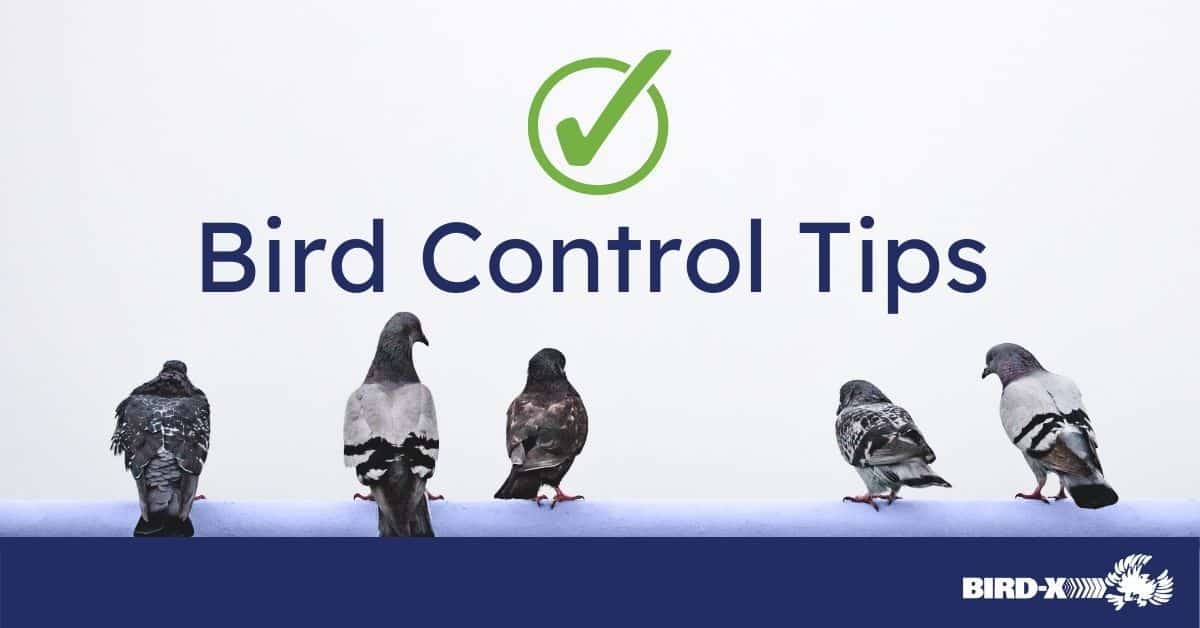6 Safety & Surveying Tips from a Bird Control Professional
Written by Tim Coughlin, National Account Manager at Bird-X
SAFETY & SANITATION
Safety is always our first step in everything we do. Before going to perform a survey for bird control, make sure you have all the PPE you need for the job. PPE can include eye protection, rubber gloves, dust masks, HEPA filter masks, shoe covers or washable rubber boots. A TYVEX suit may be recommended for extended exposure to bird droppings, live and dead birds.
When removing bird debris, your first step is to wet the affected area with a sanitizing solution. For best results, use a microbial bird cleaner labeled for bird dropping removal. When the debris starts to become dry, soak it again with the sanitizer. Proceed to bag the removed bird debris and dispose of it properly.
Before re-entering your vehicle, remove and bag your clothing and footwear that may have come in contact with bird debris and sanitizer. Wash the affected clothing separately from your other laundry.
Birds can transmit over 60 diseases that can infect humans through inhalation, dermal, oral and ocular paths. Proper safety precautions can help protect you, your family and the public from communicable diseases spread by birds.
SURVEYING
Surveying for bird control is different than most of the other pests we deal with. Look up for nests, debris and droppings. Try to narrow the areas to three main control points. Most pest birds will fly in and up to perch. The first few thousand square feet inside a building is typically where you will see birds loafing and nesting. Ask how long the birds have been a concern. What has been tried in the past? Gather information and let the prospect know you will return with multiple solutions.
BIOLOGY
Biology is very important when offering solutions to control pest birds. Knowing the life cycle, reproduction, feeding habits are all very important. Example: Pigeons have 6 – 8 clutches per year. Two eggs per clutch. In an urban environment, pigeons can live up to 5 – 6 years, and up to 15 years in captivity. Pigeons will return to the site of their birth to create a nest. Pigeons are commensal and like to feed on grain, seeds and discarded human foods. Knowing bird biology and life patterns will help to offer solutions that are effective.
RECOMMENDED SOLUTIONS
Physical barriers are the best practice solution for effectively keeping birds off of and out of buildings. Properly installed netting, shock track, bird wire, AviAngle or spikes will produce the best results. However, if the birds are nesting in the area DO NOT offer spikes as the birds will create nests in the spikes. Spikes are most effective when installed on surfaces prior to nesting.
ALTERNATIVE SOLUTIONS
Effective alternative solutions include sonic devices, ultrasonic devices, lasers and visual deterrents. If birds are nesting, the nests must be removed and the areas sanitized before installing alternative solutions. Electronic devices must be installed and maintained by a Wildlife Professional, PCO, dedicated, knowledgeable service tech. Changing the settings and observing bird activity is key in moving the birds from the infested areas. We recommend changing the settings weekly for the first 4 – 6 weeks and monthly thereafter. This will prevent the birds from becoming acclimated to the device. Some devices are very effective on specific species; some species, such as swallows and vultures, are not affected by sonic or ultrasonic devices. Consult Bird-X to discuss when and where to recommend alternative solutions.
OFFERING SOLUTIONS & MAKING RECOMMENDATIONS
Ask that all who will be part of the bird control solution be part of your proposal meeting. Offer the best practice solution — physical barriers — and be ready with a detailed plan to offer the alternative solutions. Spot treating with Bird Wire, Shock Track, Netting, AviAngle in combination with electronic devices can be very effective. When offering solutions for a building where doors are open for long periods of time, physical barriers, netting, are often recommended to include lasers, sonic and ultrasonic devices to discourage curious foraging birds from flying through.
FOLLOW-UP RECOMMENDATIONS
You won the job, installed solutions, what’s next? Inspecting physical barriers after installation is very important. Check turnbuckles on netting cables, inspect for damage in the netting from fork trucks, check the chargers in the shock track system, inspect the bird wire for damage. Other service providers, HVAC, painters, roofers, etc., occasionally cut through the netting, bird wire, turn off the shock track system to do their job. Follow-up inspections help the client maintain a bird-free environment. Follow-up inspections are a great way to grow your business, get referrals and build a solid reputation.
More Professional Advice









 Source: TASR
Source: TASR
Leave a Reply
Want to join the discussion?Feel free to contribute!